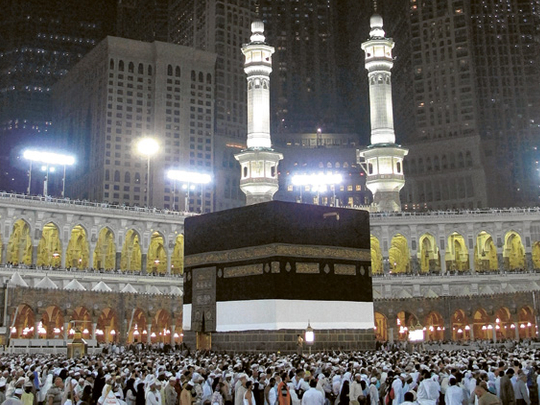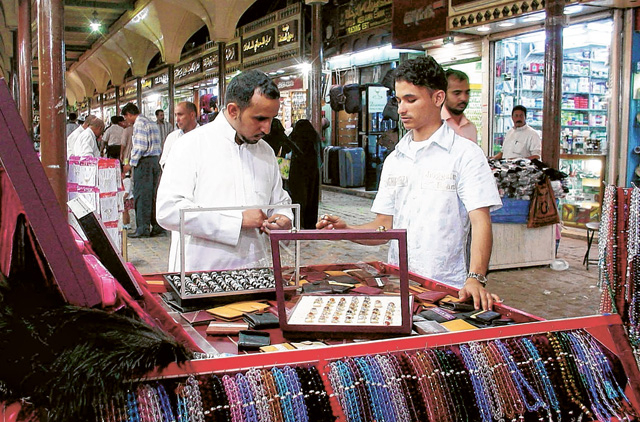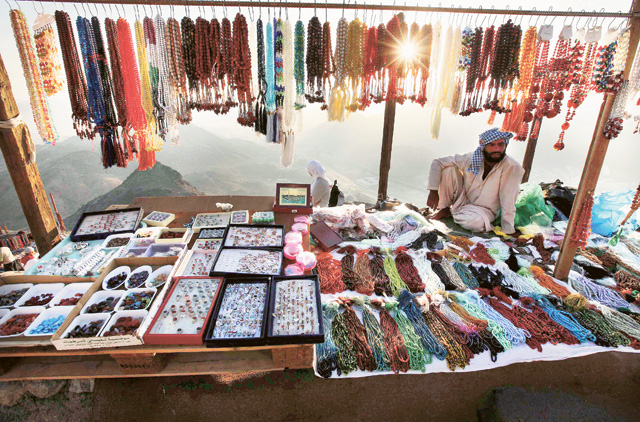
The Haj, one of the five pillars of Islam, seems to have escaped the negative impact of the international financial crisis as it continues to contribute nearly one-tenth of the non-oil private sector's share of Saudi Arabia's gross domestic product.
The season, which has been linked to the Saudi economy since the emergence of Islam 1,430 years ago, continues to defy the effect of the three-year-old crisis, which held back a myriad of economic plans, created spiralling unemployment problems and shelved infrastructure projects around the globe.
Though the crisis has not affected the religious season, many retailers in Saudi Arabia, however, believe it has had an impact on the purchasing behaviour of Muslims who come from around the world to perform the pilgrimage, which is a duty of able-bodied Muslims at least once in their lifetime.
With an estimated 40 billion Saudi riyal income generated by Haj-related activities alone, the Haj and Umrah, also called the lesser Haj, continue to encourage the spending of enormous amounts of money by the Saudi public the private sectors and visiting pilgrims.
The government is spending a huge amount on infrastructure projects to facilitate the movement of pilgrims and solve the problem of traffic jams during the Haj. According to Saudi estimates, nearly one trillion Saudi riyals was spent on several projects by the government in the past few years, all to facilitate the Haj journey.
Private sector
Unlike the public sector, the private sector in the west of the kingdom depends heavily on the season to "stir up the economic wheel for the big, middle-sized and small companies [there]," said Sa'ad Al Qurashi, head of the Haj and Umrah Committee at the Makkah Chamber of Commerce and Industry.
"Between 25 and 30 per cent of the private sector's income (in the western region) depends on the Haj and Umrah," he told Gulf News.
"The local banks [in that area] also depend on the pouring in of an amount of money that could reach more than 10 billion Saudi riyals."
According to some studies, the Haj season brings in around 40 billion riyals to the Saudi economy. The figure constitutes nearly 10 per cent of the non-oil private sector's contribution to gross domestic product (GDP).
Qurashi describes these studies as "acceptable" and "very close to reality".
The fact is that prices of most services during the Haj season increase every year. The long list includes hotel rooms, taxis, car rental, restaurants and traditional Haj presents, such as prayer beads of almost every imaginable colour and type of stone, as well as prayer mats, silver signet rings for men and the traditional embroidered black abayas for women.
Supply and demand principles dictate that the prices of these services increase considerably during the Haj and Umrah, and particularly during the last 10 days of Ramadan.
For example, the rate for a night in a single room in the main hotels around the Grand Mosque in Makkah can quadruple during the last 10 days of Ramadan and the Haj to as much as 4,000 riyals.
Furnished apartments in both Makkah and Madina, as well as Jeddah, also increase, as do other services. Some of the 1.7 million residents of Makkah rent out their homes to pilgrims and to companies arranging accomodation for pilgrims during the Haj.
The residents move temporarily to other cities in the kingdom, leaving room for massive numbers of pilgrims. Over three million people have been known to arrive, often gathering in the same place at the same time.
Also, some residents use their own vehicles to transport pilgrims around the city. The season generates tens of thousands of temporary jobs to meet the huge demand for services.
There is also a big demand for gift shops, even in other cities which pilgrims pass through on their way to Makkah. Madinah and Taif, as well as Makkah, all benefit greatly from the Haj. And Jeddah's airport, King Abdul Aziz, and the city's port serve as gateways to Makkah.
The cost of renting a car without a driver in Jeddah can jump from about 150 riyals to 210 riyals during the Haj season, note taxi drivers. The cost of a round trip from Jeddah to Makkah in a rented car with a driver, which takes five hours, could reach up to 500 riyals, and another 100 riyals per every additional hour.
Merchandise
In the old market of Jeddah, standing at his brother's shop, which sells prayer beads of all colours and types ranging from plastic to precious stones and for a wide range of prices, Mohammad Musbahi, a Yemeni who has been living in Jeddah for 30 years, says: "People are buying prayer beads by the dozen these days from our shops. They buy lots of presents too, some low-cost, others expensive and high quality. Our sales almost triple during the Haj and Umrah of Ramadan."
Even a dozen cheap beads will set you back five to 10 riyals during the Haj season. Sales during the Haj are even higher than during Umrah of Ramadan, said Hamza Saleh, a Yemeni in his late 20s, standing in front to his stall where he displays various types of beads and silver rings decorated with precious gems. Some of these stones are imported from Yemen and others are imported from Italy, he added.
"Many men also like to buy silver rings for themselves," Saleh added. "Pilgrims after the Haj like to go back to their home countries with presents from Saudi Arabia," said Mohammad Rafiq, a 39-year-old Indian who owns a shop in the old Jeddah souq that sell abayas. While prices start from 35 riyals in Jeddah, they can go up to as much as 80 riyals in Makkah and Madinah.
However, business is not booming for all shopowners. In fact, some have noticed a decline in the quantities of gifts that pilgrims are buying, as a result of the financial crisis. People, they say, can't afford to spend as much as they did previously.
"There used to be more demand," said Hussain, a 25-year-old Saudi, while standing in his uncle's shop which sells abayas. "Everything is becoming more expensive now, and many pilgrims buy only the necessary quantities of presents," he added.
The sector, however, that has been most effected by fluctuating prices on international markets is the gold shops. Gold prices have been rising significantly in recent months to record highs.
"Sales are declining in almost all of our branches in Jeddah, Makkah and Madina as a result of gold prices surge internationally," said Abdul Fatah, a salesman at a gold shop in Jeddah, who asked not to be named.
Gold buying
With almost 90 per cent of his customers pilgrims, Abdul Fatah explains that whether or not people buy gold depends on their nationality and culture, and not just their income.
"A large percentage of Nigerians, Pakistanis, Indians and Bangladeshis, as well as some Arabs, consider buying gold part of their savings," he said.
Throughout history, pilgrimages have always led to an increase in worship and trade. Pilgrims used to bring their merchandise along with them on the Haj journey, which used to take months. Along the way, whilst travelling from their homeland to Makkah, they would sell their wares and buy what they needed, helping to cover the cost of the religious journey. They would usually make a profit as well.
The journey has left its imprint on many aspects of cultural life and had an effect on other cities. For instance, the origin of the black silver material used to make the traditional costume of Jordanians living in the southern city of Ma'an, which was on the Haj route from Syria to Makkah, came from Syrian traders performing the Haj.
Saudi Arabia's neighbours have also witnessed an increase in trade during the Haj season.
Hand-made products for Muslims in the former Soviet republics can be seen for sale in some Jordanian cities before and after the Haj season. They include hand-made woollen rugs, carpets, shawls and necklaces, all at competitive prices.
And every year, with the approach of the Haj season, buses transferring pilgrims from the former Soviet republics can be seen on the streets of Amman on their way to Makkah.
25-30% share of private sector income in western Saudi Arabia depending on Haj and Umrah
- 1tr Saudi riyals spent to improve infrastructure
- 40b riyals added to the Saudi economy














